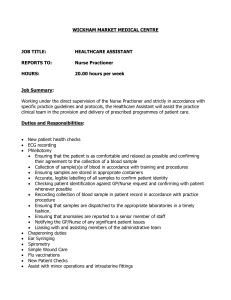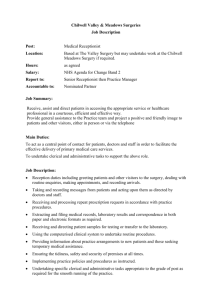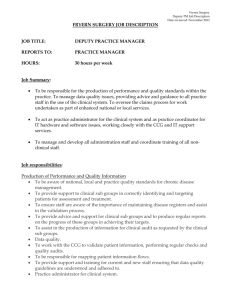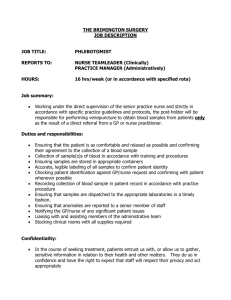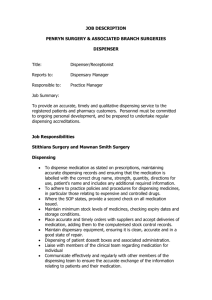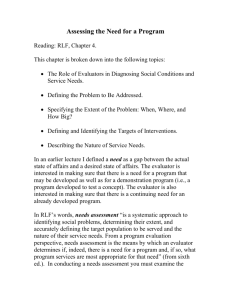Job Evaluation and Grading Support - good practice guide
advertisement
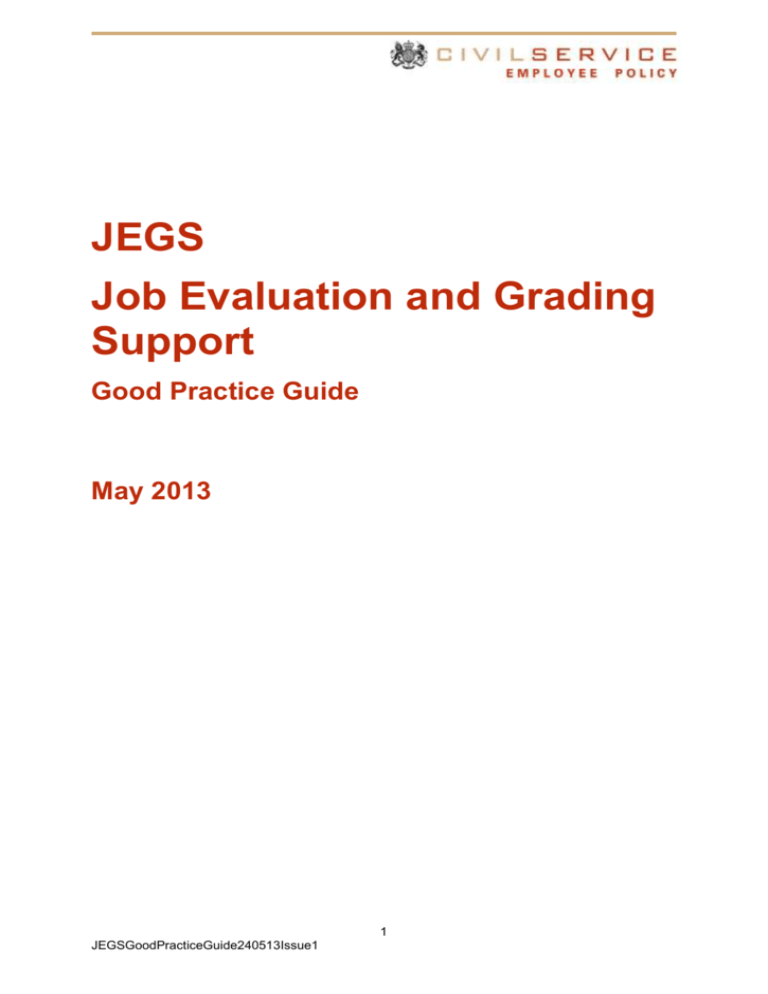
JEGS Job Evaluation and Grading Support Good Practice Guide May 2013 1 JEGSGoodPracticeGuide240513Issue1 CONTENTS Introduction ................................................................................................................. 4 The JEGS Handbook .................................................................................................. 4 Managing JEGS ......................................................................................................... 4 The Role of Job Evaluation......................................................................................... 5 Equality Issues ........................................................................................................... 5 The Law ...................................................................................................................... 5 Job evaluation ............................................................................................................ 6 Achieving fairness and consistency ............................................................................ 6 Training in JEGS ........................................................................................................ 7 The JEGS Process ..................................................................................................... 7 The Need for a JEGS Evaluation................................................................................ 7 The Key Stages in a JEGS Paper-Based Evaluation ................................................. 8 The Key Stages in a Full JEGS Evaluation................................................................. 8 Evaluating New Posts ................................................................................................. 9 Planning...................................................................................................................... 9 The Job Analysis Form ............................................................................................. 10 The Job Evaluation Interview.................................................................................... 10 Preparation ............................................................................................................... 10 The Interview ............................................................................................................ 11 Job Profiles ............................................................................................................... 12 Scoring Posts ........................................................................................................... 13 Job Evaluation Panels .............................................................................................. 13 Composition.............................................................................................................. 13 The Type of Meeting ................................................................................................. 13 Panel Scoring ........................................................................................................... 13 Governance .............................................................................................................. 14 2 JEGSGoodPracticeGuide240513Issue1 The Roles of the Post-holder and the Manager ........................................................ 14 The Role of Civil Service Employee Policy ............................................................... 14 The Role of the Trade Unions................................................................................... 15 Requests to Review Evaluation Decisions ............................................................... 15 Maintaining a JEGS Evaluation Library .................................................................... 16 Future Assurance ..................................................................................................... 16 Additional Guidance ................................................................................................. 17 Annex A - Equal Pay Legislation – A Summary ........................................................ 18 Annex B - Job Evaluation Process Flowchart ........................................................... 19 Annex C - Job Analysis Form ................................................................................... 22 Annex D - Job Analysis Form - Guidance ................................................................. 26 3 JEGSGoodPracticeGuide240513Issue1 Introduction This Good Practice Guide is intended to raise awareness of good practice in the application and maintenance of the Job Evaluation and Grading Support (JEGS) system. For JEGS practitioners, it should be used as a supplement to the JEGS Handbook. It is also intended for use by anyone else involved with the JEGS process. This Guide replaces all earlier versions of the JEGS Good Practice Guide. The changes reflect the transfer of the job evaluation policy lead from the Cabinet Office to Civil Service Employee Policy (CS Employee Policy). They include new advice on paper-based evaluations, job evaluation libraries and reviewing decisions which are disputed. The amendments have been drawn up in discussion with the Job Evaluation Network which represents HR teams involved in job evaluation across the UK Civil Service. The most robust job evaluation systems are analytical methodologies. Analytical systems break jobs down into identifiable components and then measure them against a set of common criteria (or factors). JEGS is an analytical, points-based system which has been developed to recognise the core values of Civil Service roles below the Senior Civil Service (SCS). The term ‘departments’ has been used throughout this Guide to refer to departments, agencies and NDPBs. The JEGS Handbook Guidance on the JEGS factors used to evaluate posts below the SCS is set out in the separate JEGS Handbook. This should be used by HR teams, senior managers and others undertaking evaluations or sitting on job evaluation panels. Managing JEGS It is recommended that a Job Evaluation Manager is identified within the department to be responsible for grading relativities and maintaining JEGS standards across the organisation. This responsibility should include: ensuring that CS Employee Policy approved training is used to train evaluators ensuring that only trained evaluators use JEGS to evaluate posts overseeing the maintenance of consistent grading standards by the various evaluators liaising with appropriate trade union representatives and considering their involvement in the evaluation process maintaining and holding any central database of evaluated posts and “benchmark” roles 4 JEGSGoodPracticeGuide240513Issue1 acting as a ‘super-user’ (the main administrator/database manager) for the JEGS software supporting the work of the Job Evaluation Network promoting the good practice set out in this Guide. The Job Evaluation Manager should be trained in the use of JEGS and may be given delegated responsibility for signing off paper-based JEGS evaluations (see the section on ‘Governance’ below). Departments will need to decide whether this individual is to fulfil a similar role in relation to Job Evaluation for Senior Posts (JESP) as recommended in the JESP Good Practice Guide. Where third parties outside the UK Civil Service are used to carry out individual JEGS evaluations for departments, evaluators should ensure that they hold a consultancy licence from Towers Watson. The Role of Job Evaluation Job evaluation determines the relative quality of jobs within an organisation and provides a rational basis for the design and maintenance of an equitable and defensible grading structure. Job evaluation assesses the demands of a job. JEGS is used to determine the relativities between one role and another. Individual contribution to the role is covered by mechanisms such as the Civil Service Competency Framework which is designed to help develop the right mix of skills and experience to do the job well. Performance management systems are designed to consider personal performance and contribution to organisational goals and targets. Job evaluation is separate from individual contribution. It assesses the demands of the role. Job evaluation is also not concerned with how busy a post is or how heavily it is loaded. The evaluation should focus on the nature of the tasks which need to be performed in the role and the type of responsibilities which the role requires to be undertaken. Equality Issues The law The Equality Act 20101 protects people from discrimination on the basis of their protected characteristics. These cover age, disability, gender, gender reassignment, 1 Provisions of the Equality Act 2010 only apply to Great Britain and do not change the equality law in Northern Ireland relating to age, disability, gender, general, race, religion/politics and sexual orientation. 5 JEGSGoodPracticeGuide240513Issue1 race, sexual orientation, religion, marriage and civil partnerships, and pregnancy and maternity. A summary of equal pay legislation is set out in Annex A. Job evaluation Job evaluation has attracted specific attention as a direct result of the Equal Value amendment to the Equal Pay Act now incorporated into the Equality Act 2010. This is mainly because analytical job evaluation is recognised as a sound basis on which to determine work of equal value and it therefore provides a means to ensure that equal pay issues are addressed. Care has been taken in the design of JEGS to avoid bias. Care must also be taken to ensure that evaluations do not have an impact on one group at the expense of another. The main risk to achieving fairness and consistency in job evaluation is bias which can be introduced into the job evaluation process in various ways. For example: evaluators may allow their evaluation of the role to be influenced by the qualities or characteristics of the post-holder, or may make assumptions about the role because of who the post-holder is post-holders may ‘under’ or ‘over’ sell the job challenge of their role one job group may be regarded as less important than another (e.g. head office v field jobs, administrative v specialist roles, full-time v part-time posts) there may be an excessive emphasis on current status and job titles. Achieving fairness and consistency If job evaluation is to be effective and able to support a credible, acceptable grading/pay banding structure, all forms of bias must be avoided and the evaluator must concentrate on the role and its requirements. Good practice in job evaluation is about building protection against possible bias throughout the job evaluation process. Good practice includes: involving post-holders in completing relevant job information documents when roles are evaluated using trained evaluators to assist post-holders to complete job information documents using job descriptions which follow the JEGS factors ensuring job evaluation panel members are representative of the workgroups being evaluated ensuring that evaluators and panel members are trained in equality issues anonymise any personal data on the Job Analysis Form (JAF) or job profile before the post is scored by evaluators and/or panel members 6 JEGSGoodPracticeGuide240513Issue1 involving trade union representatives to support post-holders through the process, if required to ensure transparency, keeping records for each role evaluated including the reason for each factor assessment ignoring the characteristics and qualities of the post-holder (for example gender, age and experience) and focussing on the role. Training in JEGS All those involved in evaluating posts must have been trained in the use of the JEGS methodology. This training is provided by: Beamans Management Consultants PO Box 2380 Watford WD18 1RH Tel: 01923 248322 Email: admin@beamans.co.uk www.beamans.co.uk Details of courses are on the Civil Service Learning Portal. It is desirable that members of job evaluation panels receive training and this can also be provided by Beamans. Job evaluation interviewing is a specific skill which is covered to some extent as part of the standard JEGS training. A separate course can also be run by Beamans for those who wish to develop their expertise. Evaluating posts using the JEGS methodology and conducting job evaluation interviews are skills which will develop with practice. Departments should consider allocating a more experienced evaluator as a mentor to those new to evaluation or to evaluation interviewing. The mentor may then act as the second evaluator for paperbased evaluations or as the other participant in a job evaluation interview. The JEGS Process The need for a JEGS evaluation The full evaluation process is set out in Annex B. A first step in grading posts is to consider them against the relevant grading guidance. Grading guidance is a tool designed to assist with grading new and existing posts. In the Civil Service, it is used for posts graded from Administrative Assistant (AA) to Grade 6. It provides an analytical matching of posts based on JEGS, a good level of assurance and is less resource intensive than a full evaluation. 7 JEGSGoodPracticeGuide240513Issue1 A formal JEGS evaluation should be undertaken where: a new post is created and the grade is not obvious an existing post changes significantly, raising doubt about the grade posts are on the boundary of different grades posts are subject to a grading review a grading decision is disputed. The key to achieving fairness and consistency in the application of JEGS is in obtaining factual evidence about the full scope and responsibilities of the roles being evaluated. The quality of the output from JEGS is reliant on the quality of the input. The key stages in a JEGS paper-based evaluation It is likely that the majority of JEGS evaluations undertaken by departments will be paper-based. This process involves the following steps: considering what information needs communicating to those involved including the trade unions the evaluator obtaining an agreed job description or Job Analysis Form (JAF) where possible in discussion with both the post-holder and the manager two evaluators scoring the anonymised job profile and then discussing any differences to reach an agreed scoring recommendation the outcome being signed off by a senior manager or someone formally authorised to act on their behalf. This could be the Job Evaluation Manager (see ‘Managing JEGS’ above). Paper-based evaluations should only be undertaken where the issues raised are likely to be straightforward. Where posts are likely to raise complex or disputed issues, a full evaluation should be undertaken. The key stages in a full JEGS evaluation The full JEGS evaluation process involves the following steps: Collecting the evidence considering what information needs communicating to those involved including the trade unions the completion of a Job Analysis Form (JAF) by the post-holder which is then agreed with the manager an interview of the post-holder carried out by a trained evaluator 8 JEGSGoodPracticeGuide240513Issue1 the evaluator drafting a job profile the post-holder and manager commenting on the job profile the evaluator incorporating any agreed amendments into the job profile the post-holder and manager agreeing the job profile Scoring the post the evaluator scoring the job profile using the JEGS software the job profile being considered by a job evaluation panel which discusses the job collectively and agrees an outcome. Detailed guidance on these various steps is given below. Evaluating new posts There will be occasions where evaluators are asked to comment on the grading of a post at the early stage of job design. In offering their opinion, evaluators should make clear that this is not a formal evaluation and that the grading may change as further information becomes available. Where a more formal evaluation is requested and the job description and other paperwork provided are not sufficient to carry this out, the evaluator should request the additional information needed from those responsible for creating the post. It may be helpful to share this Guide with the relevant senior managers to help them understand the process involved and the need for the information requested. Planning Approaches to JEGS exercises will vary and will inevitably depend on the numbers of jobs to be evaluated, the available resources and the process which is followed. It is important to set expectations with those involved about the amount of time it could take to complete an evaluation and to emphasise the need for the evaluator to have enough time to complete a quality evaluation. For full evaluations, sufficient time will be needed for: the issue and return of the JAF arranging and conducting the interview writing the job profile quality assuring the job profile getting the job profile agreed by the post-holder and the manager incorporating agreed changes identifying the availability of panel members and fixing a date 9 JEGSGoodPracticeGuide240513Issue1 considering how and when post-holders are to be informed of the outcome. The Job Analysis Form A key stage in any evaluation is to obtain sufficient information about the role to enable it to be scored against the relevant factors. This information needs to reflect the current post so should only cover the previous twelve months. To help evaluators to collect this information, a sample Job Analysis Form (JAF) is contained at Annex C. It has been designed to complement the JEGS process and to capture the information which will help to score the post. Departments should consider issuing guidance and offering support from a trained analyst to help postholders and managers complete the JAF. Sample guidance to help with the completion of a JAF, is attached at Annex D. Where a full evaluation is being undertaken, the JAF will form the basis for the interview. Where a JAF has not been completed, the interview may need to be based on a job description possibly with other background papers. The aim of the interview will be to complete a full job profile. Those undertaking paper-based evaluations may also start the process with a job description and some other background papers although, where possible, they should start with a completed JAF. These evaluators may also need to go back to the post-holder and/or manager on a more informal basis to ensure that they have sufficient information on which to base their evaluation. Apart from the JAF, evaluators should consider whether any other background information will be useful before conducting the interview or carrying out the paperbased evaluation (e.g. anything which will help to put the role to be evaluated in context or which will improve the understanding of the work processes and terminology). Care should be taken, however, not to pre-judge the outcome of the job evaluation based solely on this research. The Job Evaluation Interview The purpose of the job evaluation interview in the full evaluation process is to obtain additional information so that the evaluator has a full picture of the job on which to base the evaluation. Preparation The department will need to decide how many people should conduct each interview. Experienced interviewers often operate alone. Less experienced ones may prefer to work in pairs or with a more experienced interviewer in a mentoring relationship. If the latter approach is adopted, the normal convention is to have one person in the lead, with the other person taking notes and having an opportunity to ask questions at the end of each section. Normally the person in support will complete the job profile. It is recommended that the evaluator has a completed JAF ahead of the interview. This allows the evaluator time to prepare the areas which should be covered during 10 JEGSGoodPracticeGuide240513Issue1 the discussion, saving time at the interview and potentially making agreement of the final job profile easier. Occasionally, they may have to undertake the interview without a JAF. Although more difficult and often more time consuming, the experienced evaluator should still be able to achieve the desired outcome. Ahead of the discussion and to save time on the day, it is worth outlining the process and timing to the post-holder and the manager. The interview It is recommended that the interview is held face-to-face but it can be successfully undertaken over the telephone or through video conferencing. During the introduction, the interviewer should confirm: the anticipated length of the interview. Not allowing enough time will result in insufficient evidence to assess the role and will probably cost additional time in going back to the post-holder at a later date. Rushing through a discussion may also reduce the credibility of the evaluator and the JEGS process with the post-holder the end product (e.g. a job profile three to four sides in length which will capture the essence of the job and be sent to the post-holder to agree) that the key to a successful interview is to establish the post-holder’s specific role the structure of the interview – normally following the sequence of the JAF that it is the post which is being reviewed, not the post-holder’s own performance, qualities or characteristics. The current post-holder is being consulted as a key source of information about the job that they are happy to answer any questions which the post-holder may have. The interview should be used to obtain factual information about the role’s activities taking into account the areas covered by the JEGS factors. Whenever possible, open questions should be used. The structure will be up to the interviewer but care should be taken to ensure the interview flows and progresses naturally from one area to another. Many of the questions will be apparent from the JAF (e.g. gaps, further information needed, lack of clarity, post-holder’s input). The evaluator may find it useful to summarise points and check back with the post-holder as the discussion progresses. Apart from the normal rules about conducting the interview with privacy, it is worth holding the interview as near to the post-holder’s workplace as possible. This will make it easier to obtain supporting evidence about the role. Also, post-holders will usually feel more comfortable having a discussion close to their place of work. Sometimes it can be useful to have others sitting in on a JEGS discussion. For example, a trade union representative may be present to support the overall fairness 11 JEGSGoodPracticeGuide240513Issue1 of the process or a “specialist” post-holder may attend to ensure that the interviewer understands all of the information received and does not leave out any key areas. At the end of the interview, the post-holder should be given the opportunity to comment on any aspects of the job not covered. The evaluator should also ensure that, if necessary, either party can get back to the other in order to clarify information. The evaluator should conclude by explaining the next phase of the JEGS process. Departments should ensure that evaluators are briefed to give common messages on how JEGS is being applied in the organisation and on the information which will be issued as a result. Job Profiles To ensure that evaluators produce consistent job profiles, many departments have introduced quality assurance checks at the draft job profile stage. Although this approach is resource intensive, a high level of consistency is achieved. The normal convention is to follow the headings in the JAF. There is no right length for a job profile although most organisations can produce a fully comprehensive one in three to four sides of A4. Some points to consider include: ensuring information is factual avoiding using emotive language avoiding using jargon and value judgements avoiding any references to the current post-holder’s characteristics, e.g. gender, age or experience aiming to capture the essence of the job ensuring the profile contains sufficient examples avoiding paraphrasing the JEGS Handbook. Most departments allow half a day to a day to complete a job profile. The evidence is likely to be more accurate if it is written up as soon as possible after the interview. Some departments produce notes following interviews rather than a full job profile. The information is contained within one to two sides of A4 and is recorded under the JEGS factor headings. In these cases, a score for each factor and a total score is provided by the evaluator for the scoring panel to consider. The JAF is also made available to the panel. The job profile should be sent to the post-holder and their manager to sign off the accuracy of the evidence before evaluating the role. It will then have the status of an agreed job profile. 12 JEGSGoodPracticeGuide240513Issue1 Scoring Posts Guidance on scoring posts using the JEGS factors is given in the JEGS Handbook. Job Evaluation Panels Job evaluation panels are responsible for scoring and agreeing the evaluation outcome where a full evaluation is undertaken and may also be used for paper-based evaluations. They may, additionally, be given a role in ensuring the wider consistency of evaluations across the department and helping to maintain the integrity of JEGS. Some departments use an existing committee or forum to carry out the role of a job evaluation panel. In making evaluation decisions, these bodies should also follow the good practice guidance set out below. Composition Where they are used for paper-based evaluations, panels should comprise a minimum of two trained evaluators. For full evaluations, panels should comprise at least three people and be chaired at a senior level. It is recommended that someone from the management chain is in attendance. The evaluator should also normally be present to support the panel and may form one of the members. To help with its quality assurance role, CS Employee Policy should be notified of panel meetings and invited to attend. The type of meeting While it is recommended that the panel meets face-to-face, discussions can take place over the telephone, through video conferencing or by correspondence. Departments need to be careful that sufficient discussion takes place and there is sufficient opportunity for views and assumptions to be challenged. Panel scoring The evaluator will normally provide a proposed outcome to the panel. Where a second evaluator is involved, the two evaluators should review the proposed outcome before the panel meeting. It will then be up to the panel to ratify or change the proposal. To save time on the day, the agreed evidence and proposals should be put to the panel in advance of the meeting. Jobs should be scored from the best available information about the job. This is normally in the form of the job profile which should be agreed by the post-holder and the manager. Where agreed job profiles are used, it is recommended that this is the only piece of information available to the panel. This ensures that a consistent approach is maintained. The job profile should contain sufficient information to enable the post to be scored with confidence. 13 JEGSGoodPracticeGuide240513Issue1 The convention is for individual panel members to read the job profile and produce a proposed score broken down into factors. This forms the basis for discussion amongst the panel members who then reach agreed conclusions. Where jobs of varying quality are to be assessed on the same day, it can be helpful to start with the more senior posts which can provide useful benchmarks. At the end of the scoring process, all total and factor scores should be compared to ensure that the approach and output has been fair and consistent. The ranking produced should reflect the importance of the posts to the organisation. During the process, it is helpful for someone to undertake a secretarial function and make notes of all discussion points. These can be very helpful in dealing with requests to review the decision. Governance Departments will need to determine an appropriate governance route to ‘sign off’ evaluation outcomes. This is particularly important where paper-based evaluations are undertaken. The person signing off the evaluation outcome should be a senior manager or someone formally authorised to act on their behalf, for example the Job Evaluation Manager identified under ‘Managing JEGS’ above. This person may attend panels for full evaluations so that the scoring decision can be taken at the panel meeting. The Roles of the Post-holder and the Manager Both have a key role to play in the JEGS process. In the full JEGS process, it is important that the JAF is completed by the post-holder and agreed by the manager. Similarly, a completed job profile should be agreed by both parties. A similar approach of involving both the post-holder and the manager should be adopted for the job description or JAF used in a paper-based evaluation. This approach will help to ensure that the job is fairly and accurately reflected. It will reduce the need for further discussions to clear up misunderstandings and the number of decisions which need to be reviewed. While the involvement of the post-holder is crucial, it should always be remembered that it is the post and the qualities and experience which it requires which are being evaluated and not the post-holder with their particular characteristics and qualities. It is important that the respective roles of the post-holder and manager are conveyed clearly before the start of the process. Where departments are undertaking an organisational review, an effective communications strategy will secure co-operation and contribute significantly to the smooth running of the project. The Role of Civil Service Employee Policy CS Employee Policy is responsible for the integrity of core JEGS and helps to ensure consistency of application. This includes: 14 JEGSGoodPracticeGuide240513Issue1 maintaining and developing the JEGS methodology in consultation with Towers Watson (who own the copyright to the software) overseeing training standards through a framework agreement held with the training provider approving departments’ amendments to the JEGS Handbook providing advice to departments on specific issues and promoting good practice. Requests for CS Employee Policy to participate in panels or to assist with other queries should be submitted using the following email address: contact.us@csemployeepolicy.gsi.go.uk The Role of the Trade Unions Departments are encouraged to consider the role of their trade unions in the JEGS process. Some departments have, for example, successfully included trade union representatives on their JEGS scoring panels. Some have an agreement to share JEGS scores with local trade union representatives who have been trained in JEGS and who may be actively involved in the evaluation process. We recommend that trade unions should be notified of planned JEGS reviews. Departments should make arrangements to ensure that any trade union representatives taking part in job evaluation panels are trained in JEGS. Requests to Review Evaluation Decisions Where an evaluation decision has been taken on a post by a job evaluation panel, it is unlikely that there will be a case for reviewing that decision. The post-holder should be informed about the decision. However, there may be a need to review a full or paper-based evaluation where it appears that: there has been a failure of process, for example, the relevant guidance has not been properly followed significant new information or significant aspects of the post have not been taken into account when arriving at the evaluation outcome, or some form of discrimination (unfair, biased or inconsistent treatment) has occurred in the way the evaluation was carried out. It may be possible to resolve some issues through informal discussion but where this does not resolve the situation, a more formal process may need to be followed. This might then involve: a clear timetable with reasonable time limits so that everyone understands how long the process will take and when it will be completed 15 JEGSGoodPracticeGuide240513Issue1 carrying out a full evaluation if the role has not already been fully evaluated where the post has been fully evaluated, convening a further evaluation panel to review the scoring outcomes. This panel could include members of the original panel alongside new, independent members. Departments will need to consider who will decide whether reviews should be granted and on what basis. Post-holders should receive a written explanation of why a request for a review has been turned down and should be advised in writing of the outcome of any review. Managers’ views may be sought as part of the review process but they should not be able to determine whether or not a review goes ahead. Whatever processes are put in place, post-holders should be made aware of the options available to them. Maintaining a JEGS Evaluation Library Departments should hold libraries of evaluations. These are helpful when looking to identify roles for benchmarking and providing quality assurance. As a minimum, a record should be maintained which shows the following for all posts which have been evaluated: the date of the evaluation an anonymised job description/JAF/job profile scores by factor the finally agreed overall score the evaluated pay band. Departments should have regard to their duties under the Data Protection Act (DPA) when retaining documents relating to evaluations. The above documents will not normally relate to individuals but to the post in question and therefore the DPA would not apply. However, care should be taken in circumstances where there is an evaluation of an existing post-holder’s role to analyse whether the information retained relates to the post-holder concerned and could lead to that post-holder being identified in which case the DPA would apply. Future Assurance In many cases, the characteristics of posts will change over a period of time. Managers have a lead responsibility for monitoring these changes and taking action where a change of grade may have occurred. Departments may also need to plan further JEGS exercises and to assure themselves that the current JEGS score/range is correct. Departments should review their grading structures and guidance at regular intervals to ensure that they are fit for purpose. 16 JEGSGoodPracticeGuide240513Issue1 Additional Guidance The Equality and Human Rights Commission’s Equality Act 2010 Code of Practice provides detailed guidance on equal value and equality issues generally. ACAS also has some useful material on job evaluation which can be accessed via the internet at www.acas.gov.uk 17 JEGSGoodPracticeGuide240513Issue1 Annex A - Equal Pay Legislation – A Summary The law relating to equal pay is contained in both European Community (EC) law and in UK statute. UK legislation is required to conform with EC law. The domestic legal framework for equal pay for work of equal value is provided within the Equality Act 2010. Where issues related to equal pay cannot be resolved informally, a complaint can be made to an employment tribunal. Claims are generally taken under domestic law where possible, but in some circumstances claims may be referred to the Court of Justice of the European Union. In essence, this legislation makes gender discrimination in pay and conditions of service unlawful. In order to establish a prima facie equal pay claim an employee in the United Kingdom must first identify an employee of the opposite sex, in the same employing organisation, who is paid more and establish that: the work which they do is the same, or broadly similar provided that there are any differences in the work and these are not of practical importance (known as ‘like work’); or the work which they do is different but is rated under the same job evaluation scheme as being work of equal value (known as ‘work rated as equivalent’); or the work which they do is different but of equal value in terms of factors such as effort, skill and decision-making (known as ‘work of equal value’). It is then for the employer to identify the reason for any difference in pay. If the employee can show that the reason is either directly related to their gender, or has an adverse effect on employees of that gender, then the employer will be called upon to justify the reason for the difference in pay. If the employee cannot get over the first hurdle of proving like work, work rated as equivalent or work of equal value, they will not be able to establish a prima facie claim. In considering this question, an employer will be in a much stronger position if the job in question has been subject to a formal analytical job evaluation process. Claims based on equal value (i.e. where the person is doing a different job but the work done is of equal value to the higher paid comparator) can be brought, whether or not there are job evaluation arrangements in place in the organisation. In cases where an analytical job evaluation scheme is not being used by the employer, a tribunal can appoint an independent expert to assess equality using an analytical job evaluation methodology. In cases where an analytical job evaluation scheme is being used, this will provide a defence to an equal value claim unless the job evaluation is held to be flawed or has not been properly followed. 18 JEGSGoodPracticeGuide240513Issue1 Annex B - Job Evaluation Process Flowchart Consider a JEGS evaluation when… a new post is created and the grade is not obvious an existing post changes significantly, raising doubts about the grade posts are on the boundary of different grades posts are subject to a grading review a grading decision is disputed Manager considers role against the grading guidance, if available, and decides upon a grade Manager consults with others if appropriate Manager discusses outcome with post-holder, if appropriate Agreement That the post is correctly graded using grading guidance Grading unclear Full Evaluation Paper-based Evaluation A paper-based evaluation by a trained evaluator using an agreed A paper and interview based evaluation using an agreed job profile job profile Quality Assurance Evaluation quality assured with another trained evaluator and outcome benchmarked Audit Records Evaluation Panel discuss and agree grade Senior manager to sign off evaluation Manage Outcome Manager advises post-holder of outcome and their options, including a decision review Record outcome Place details of evaluation in Job Evaluation Library 19 JEGSGoodPracticeGuide240513Issue1 Job Evaluation Process – text version Consider a JEGS evaluation when: a new post is created and the grade is not obvious an existing post changes significantly, raising doubts about the grade posts are on the boundary of different grades posts are subject to a grading review a grading decision is disputed. Step 1. Manager considers role against the grading guidance, if available, and decides upon a grade. Yes: go to step 6 No: go to step 2 Step 2. Grading unclear. Yes: go to step 3 No: go to step 5 Step 3. A paper-based evaluation by a trained evaluator using an agreed job profile. Yes: go to step 4 No: go to step 8 Step 4. Evaluation quality assured with another trained evaluator and outcome benchmarked. Maintain audit records throughout the process. Step 5. Senior manager to sign off evaluation. Step 6. Manager advises post-holder of outcome and their options, including decision review. Step 7. Place details of evaluation in Job Evaluation Library. End of process. Step 8. A paper and interview based evaluation by a trained evaluator using an agreed job profile. Step 9. Evaluation quality assured with another trained evaluator and outcome benchmarked. Maintain audit records throughout the process. Step 10. Evaluation Panel discuss and agree pay grade. 20 JEGSGoodPracticeGuide240513Issue1 Step 11. Manager advises post-holder of outcome and their options, including decision review. Step 12. Place details of evaluation in Job Evaluation Library. 21 JEGSGoodPracticeGuide240513Issue1 Annex C - Job Analysis Form JOB ANALYSIS FORM Job title Grade Team/ Business Unit/Location Completed by Date Telephone no. Manager’s name Date agreed with manager Job Summary Please give a summary of the role, key responsibilities and deliverables. Position within the Organisation Please provide or attach a chart showing the position of the role in the organisation in relation to its managers, colleagues and the employees it manages. Main Activities Please list the main activities and estimate the percentage of time spent on each. Activity % time 22 JEGSGoodPracticeGuide240513Issue1 Knowledge and Skills What knowledge is needed to be able to undertake the responsibilities of the role? Please detail any necessary professional/academic qualifications. What skills are needed? What experience is needed? Contact and Communications Please give examples of the contacts which are typically required in order to carry out the responsibilities of the role. Exclude contacts within the immediate work area but include all types of communication with others as follows: Within the organisation: Level Purpose Frequency With other government organisations: Level Purpose Frequency With external organisations (e.g. local authorities, customer groups, members of the public): Level Purpose Frequency 23 JEGSGoodPracticeGuide240513Issue1 Problem Solving Please give examples of the depth and range of problems dealt with by the postholder, their frequency and the levels of analysis and judgement needed. When solving problems, who does the post-holder involve? What range of options is open for their solution? Decision Making What day-to-day decisions are the sole responsibility of the role (i.e. those which do not need approval by others)? The post-holder should provide four to five examples and say how often they are made. What advice/recommendations are given to others to help with their decisions? Autonomy What guidance is available to the role from senior managers, rules and regulations, precedents and set instructions? Management of Resources Is the role responsible for the control of budgets, equipment or other resources? If so, what are they and what is required in managing them? In what aspects of the role is team leading and leadership required? How much time is required for team working/leadership issues? 24 JEGSGoodPracticeGuide240513Issue1 Does the role have line management responsibility for employees or is it responsible for getting a task done? If the role has line management responsibility, what is the size of the team? Impact What impact does the role have on the organisation? How far reaching is the impact? Will it have a short or long term effect? Additional Information Please include any additional information which might be helpful and is relevant to the role. 25 JEGSGoodPracticeGuide240513Issue1 Annex D - Job Analysis Form - Guidance Introduction This note provides guidance on the completion of the Job Analysis Form (JAF). It is based on the seven JEGS evaluation factors. It is important to remember that it is the post which is being evaluated and not your performance. The form should outline the key aspects of the post and should include enough information to give an idea of what it involves. This information needs to reflect the current post so should only cover the previous twelve months. It is not necessary to provide documents which are used as part of your job such as guidance, instructions or policy statements. It is important that you provide accurate information which is clear and unambiguous, and that you avoid using jargon and unexplained acronyms. Please support general descriptions with specific examples of things you do, how you do them and the result. If you require any further assistance, please speak to your manager who will need to sign off the form. Questions Job Summary This is the reason the job exists. A brief statement is required to describe the purpose of the post, its responsibilities and the main objectives (excluding your own personal objectives) and deliverables. Position within the Organisation Please provide an organisation chart showing the position of the post in relation to your manager, any employees who you manage or for whom you are responsible, and your colleagues. This is to show the relationship between your job and others in the same team or business area. Main Activities Please list the main tasks of the job and estimate the percentage of your time normally spent on each activity/task. This should identify what you spend most of the time doing and not exceptional or one-off tasks. Please note you should only list what the post requires, rather than what you think it should do. Knowledge and Skills This factor seeks to determine the level of qualification necessary to do the job. You should list the knowledge, skills and experience necessary to perform the role. When completing this section, please consider the following: what knowledge, skills and experience, however gained, does the post need to carry out the day-to-day responsibilities? 26 JEGSGoodPracticeGuide240513Issue1 how is the knowledge and experience applied? how often is there a need to update the knowledge and experience? who routinely looks to you for advice or guidance? what level of knowledge and experience would be required if the post was advertised externally? Contacts and Communications This factor measures the contacts and communications which the post has to have with people inside and outside the organisation to carry out the job effectively. It seeks information on the level and purpose of contacts within the organisation, the rest of the public sector and with the private sector. It includes all business-related communication, whether conducted face to face, by telephone or in writing. Do not include immediate work colleagues, managers or employees within your team. When completing this section, please consider the following: who do you talk to and write to as part of the job? what type of information is exchanged? how do you decide what to communicate and when to communicate it? who do you liaise with and why? why is communication important and how often does it occur? what information do you typically pass on or receive? Problem Solving This factor measures the demands and challenges of the post and the skills required to tackle and solve the problems and issues arising. It includes analysis, judgement, initiative and original thought as well as the size, scale, depth and breadth of the problems and the involvement of other people in their solution. When completing this section, please consider the following: what are examples of typical problems? how often does this type of problem occur e.g. on a daily or monthly basis? what do you need to do about them? what options are considered and how is the best course of action selected? do you need to generate new or creative approaches? do you act on you own, as part of a team or manage other people to develop solutions? 27 JEGSGoodPracticeGuide240513Issue1 do the problems affect individuals, small teams, other teams across the organisation or external customers? is there existing legislation, guidance or precedent, or do you modify an existing approach? Decision Making This factor looks at the types of decisions taken directly by the post-holder without reference to others further up the management chain, and the influence the post needs to have on the decisions taken by others. This includes putting forward proposals or recommendations for senior managers to consider and decide upon. Do not include decisions which are taken by others, for example, expenditure countersigned by a more senior manager. When completing this section, please consider the following: what authority do you have to make decisions without the agreement of others? how are typical decisions made which you are involved in and what are the results of making them? who else is involved in making the decisions and how do you contribute? how regularly are these types of decisions made? who or what do they impact and over what timescale? do decisions affect individuals, small teams, other teams across the organisation or external customers? are there existing practices, procedures and guidelines or do you set new precedents? Autonomy This factor judges the extent to which the work of a post-holder is managed by others and the degree to which you are bound by rules, regulations and precedent. It relates to the freedom of action allowed to the post. When completing this section, please consider the following: how well defined is the post? Does it follow established working practice? to what extent is the work checked or reviewed by more senior employees? how far is the post is defined in terms of legislation, guidelines, codes or other written instructions? 28 JEGSGoodPracticeGuide240513Issue1 how far is the post defined in terms of practice or precedent? For example, have similar tasks been done before and can that work be used to point the way forward? how far is the post defined in terms of policy, for example is the line to take established? what authority do you have to make decisions without the agreement of others? Management of Resources This factor looks at the responsibility for managing budgets and equipment, leading the work of others and managing and reporting on the work of others. This section is divided into three sub-factors. Financial Resources This section looks at whether the post-holder has a budget, or operates a delegated budget, or handles project based expenditure. When completing this section, please consider the following: does the post hold budgetary or financial responsibility? do you have the authority to approve expenditure? are you accountable for any spending? what is the scope of the budget? Is it for a small project or across a business area? do you have any discretion on how the money is spent? Leadership and Team working This section looks at the post-holder’s responsibility for managing a project or supervising people within the organisation. It assesses the job demand to motivate, lead and develop employees, and achieve objectives through others. When completing this section, please consider the following: are you a team member with no responsibility for leadership or do you manage or supervise a discrete area? are you responsible for managing a project or a particular piece of work which involves co-ordinating the work of others? is there a requirement to empower others or to take responsibility for team performance? do you set the direction of a team or a number of teams? 29 JEGSGoodPracticeGuide240513Issue1 The Nature of the Management Role You should include the total number of employees which you manage including those directly managed, as a countersigning officer and those for whom the post is the head of the Section or Unit. When completing this section, please consider the following: do you carry out performance management action for any employees? what percentage of time is spent on managing people? is the post a senior team manager/leader with responsibility for teams across a large part of the organisation? are the employees based in one location or on multiple sites? Impact This factor examines what positive impact the post will have on the team, business or organisation. This includes the impact on: internal or external relationships; revenue generation; the organisation’s image; the achievement of objectives and any other factors which may impact on the organisation/section’s performance. When completing this section, please consider the following. You should focus on key activities rather than things which only happen occasionally. Does your work directly affect the operational targets/activities of the organisation or does it only affect those in the immediate work area? Does your work support and influence work in other departments or organisations? Additional Information You can include here any other information which you feel would be helpful to understand the post. 30 JEGSGoodPracticeGuide240513Issue1
